Best White Cake Recipe
This White Cake recipe is soft and velvety with perfect vanilla flavor.
Have you ever taken a bite of a beautiful white cake only to be disappointed by it’s rubbery texture and bland taste? With the proper ingredients and mixing technique you can make the best White Cake at home, from scratch.
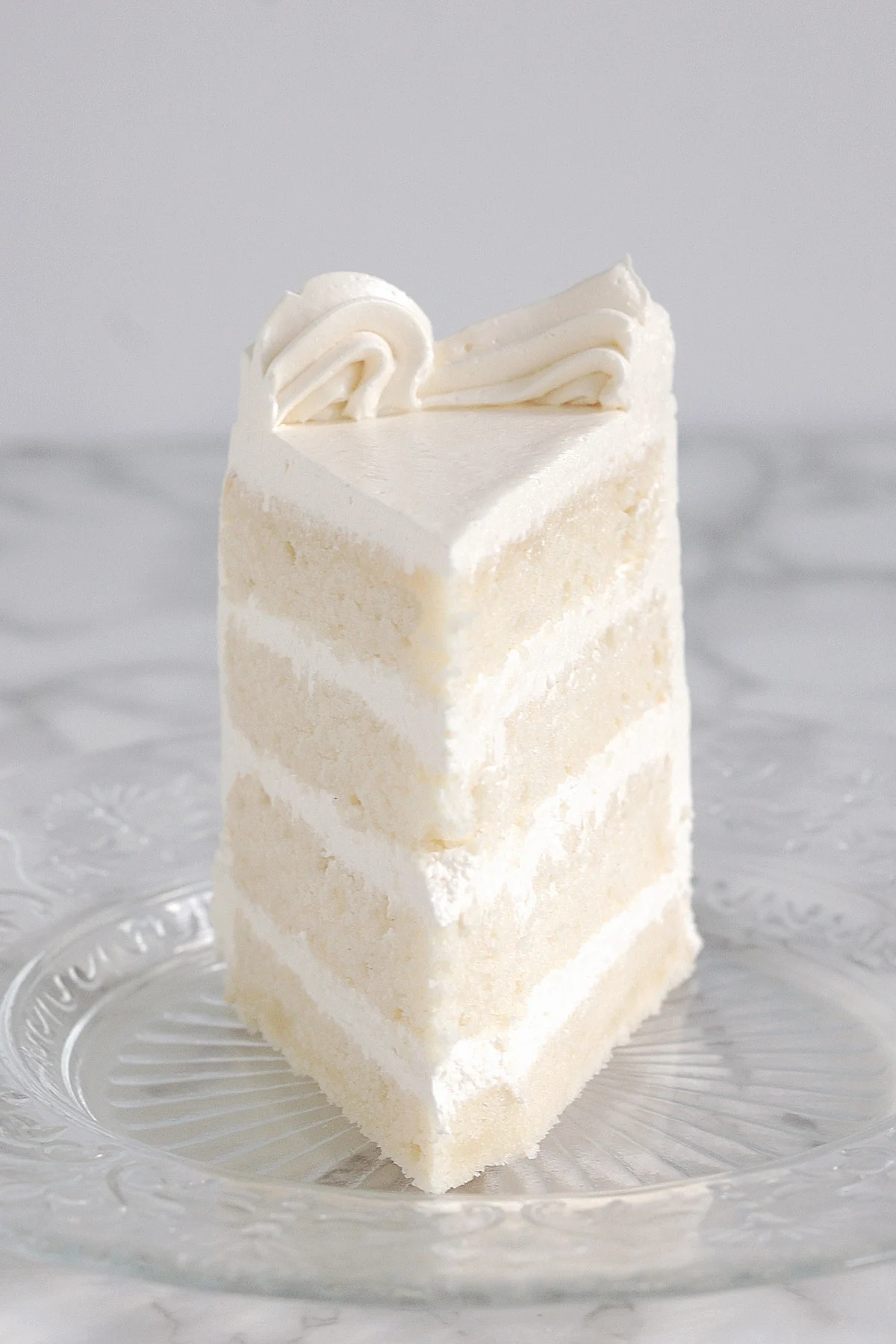
Science behind the recipe
If you’re into baking science and want to learn how I developed and tested this recipe you can visit this post where I explain in detail how I created the best White Cake recipe.
Ingredients
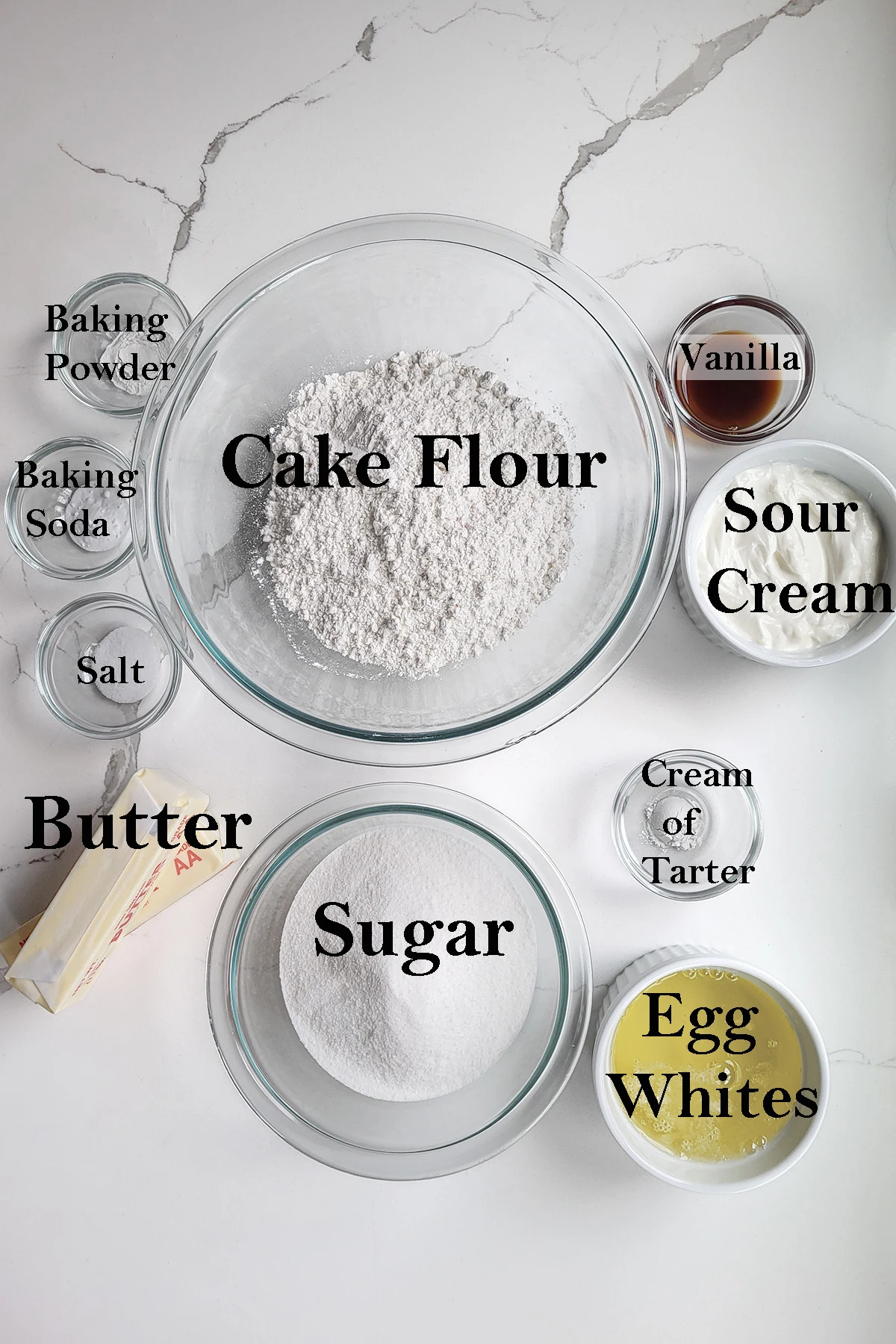
Ingredient Notes
- Cake Flour – I prefer bleached cake flour because it is slightly acidic and whiter in color.
- Sour cream – Sour cream enriches and tenderizes the cake.
- Vanilla extract – Use real vanilla extract for the best flavor. (Alternately, you can use almond extract to make White Almond Sour Cream cake.)
- Egg whites – The main difference between a White Cake and a regular vanilla cake is the absence of yolks in the batter.
- Cream of tartar – Stabilizes the whipped whites.
Process Photos
Here’s what the recipe process looks like at each stage. Refer to the recipe card below for measurements and exact instructions.
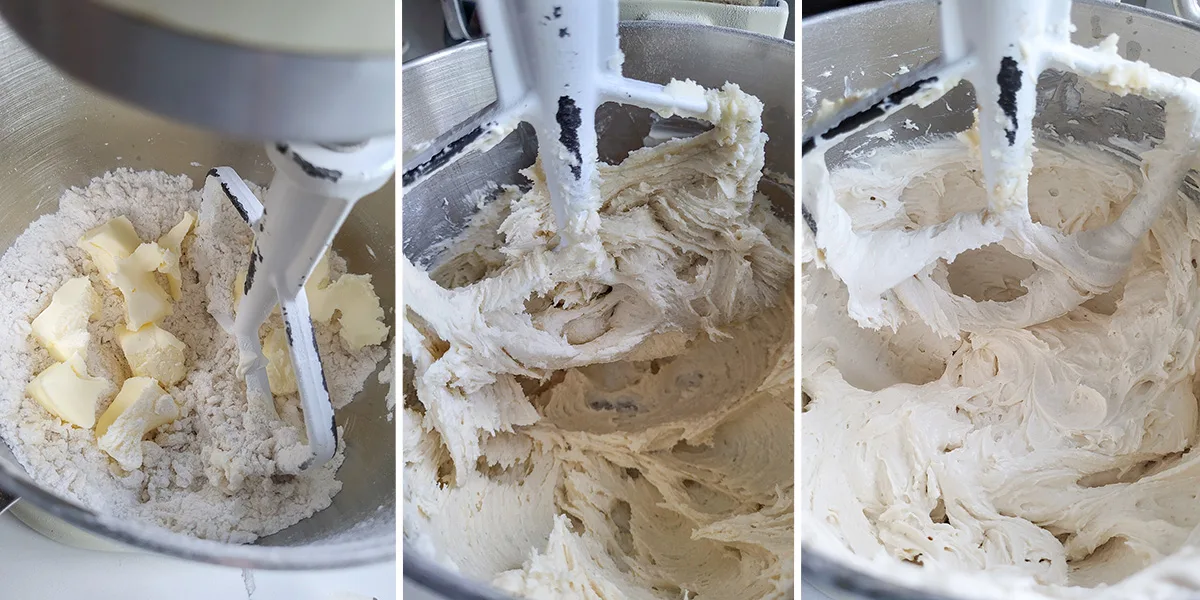
- Sift the dry ingredients into a mixing bowl. Add half the sour cream and combine. Then add the softened butter.
- Mix until the butter is completely incorporated. Scrape down the sides of the bowl.
- Add the remaining sour cream and vanilla and mix on high speed 2-3 minutes to aerate.
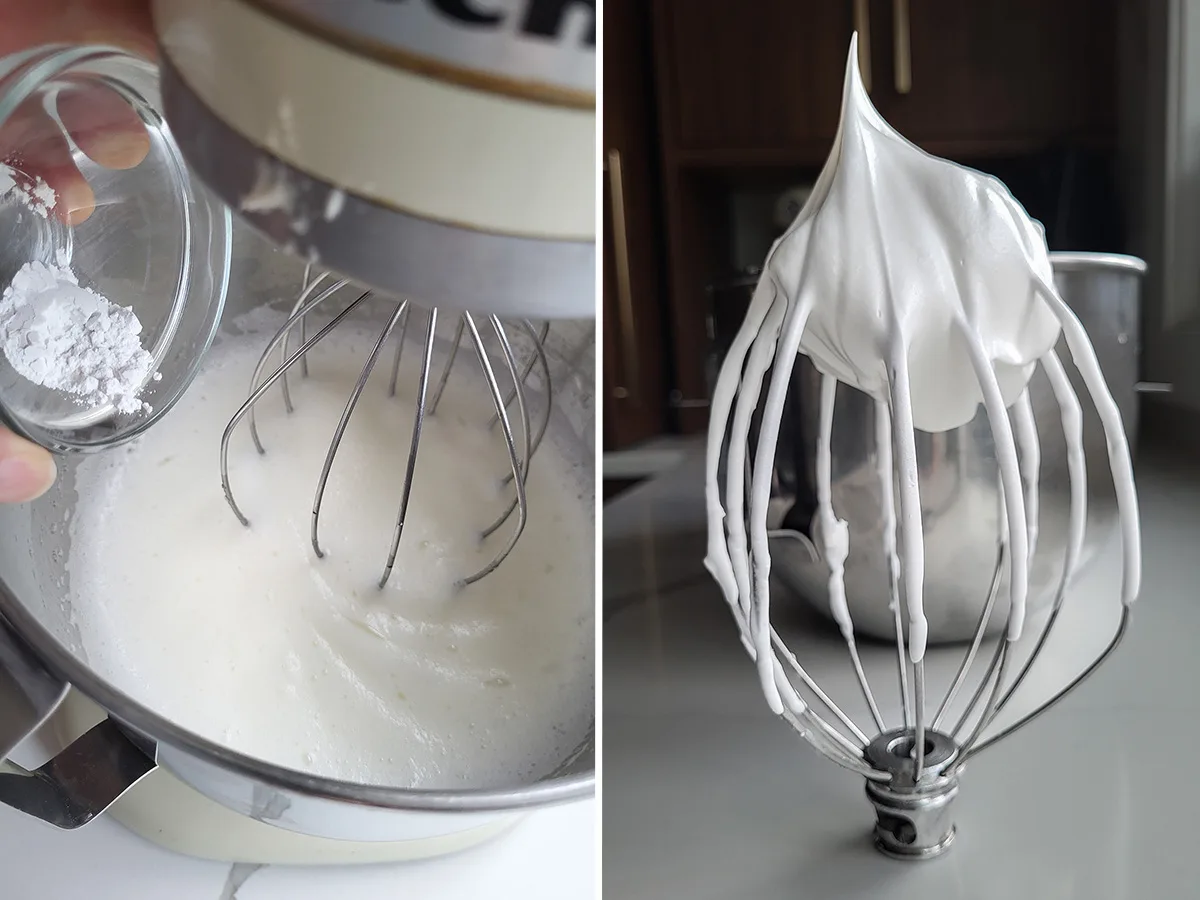
- In a separate bowl, whisk the egg whites with the cream of tarter.
- Add the sugar and whisk to full peak.

- Fold the egg whites into the batter in three batches.
- Fold just until there are no streaks of egg white.
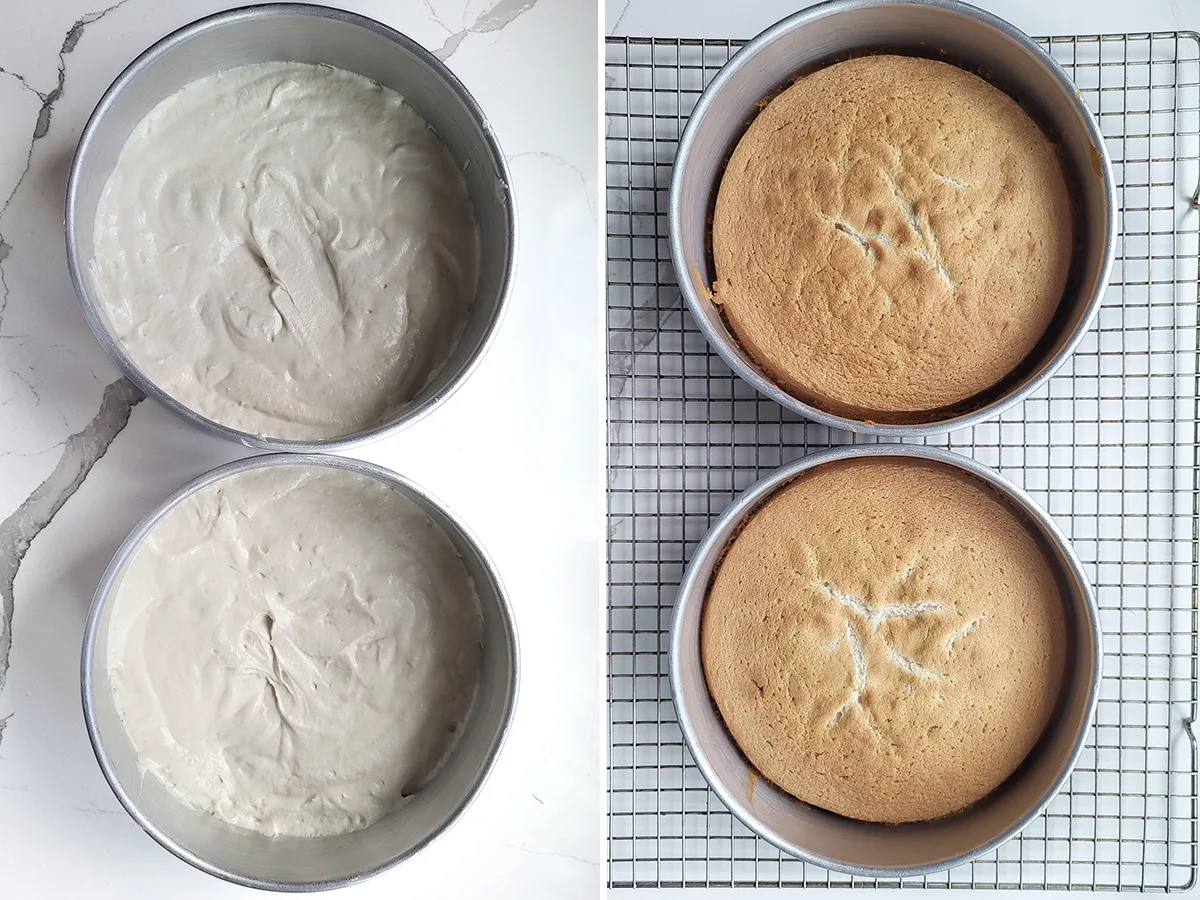
- Divide the batter between two cake pans. Do not butter the sides of the pan or use a non-stick pan.
- Bake until the center of the cake springs back when pressed. Allow the cake to cool completely before frosting.
White Cake Recipe Tips
- Use Room temperature ingredients for the lightest batter. Room temperature butter is between 65°F and 70°F. It should be slightly pliable but not soft and melting.
- Using the “reverse creaming” method to mix the batter makes a soft and fluffy cake. Whipping the whites in the cake also makes the cake soft and fluffy.
- Do not use pasteurized egg whites as they may not whip up properly.
- Do not butter the sides of the cake pan or use a non-stick pan. The cake will rise higher as it clings to the sides of the cake pan. Butter and flour the bottom of the pan or use a round of parchment paper.
- The cake will often “settle” as it comes out of the oven because of the whipped whites in the cake. The soft texture of the cake is well worth the slight shrinking.
- Do not overbake the cake. Remove it from the oven as soon as the cake springs back when the center is pressed.
Storage
- The cake can be kept at room temperature for several days (unless it has a perishable filling).
- If the cake has a perishable filling store it in the refrigerator for up to 3 days.
- Leftover slices of cake can be individually wrapped and frozen for up to 3 months.
- Un-iced, the cake can be wrapped in two layers of plastic wrap and frozen for up to 3 months.
What Frosting Should I Use for My White Cake?
I love to fill and ice Velvety Soft White Cake with snow-white Ermine Frosting. I also recommend Italian Meringue Buttercream, Swiss Meringue Buttercream, Seven Minute Frosting or American Buttercream frosting for this cake.
What the difference between white cake and vanilla cake?
Most of the yellow color in a vanilla cake comes from the egg yolks. White cake is made with only egg whites and no yolks.
Now that you’ve made this recipe what should you do with the extra yolks? Check out this collection of recipes that use extra yolks for some great ideas.
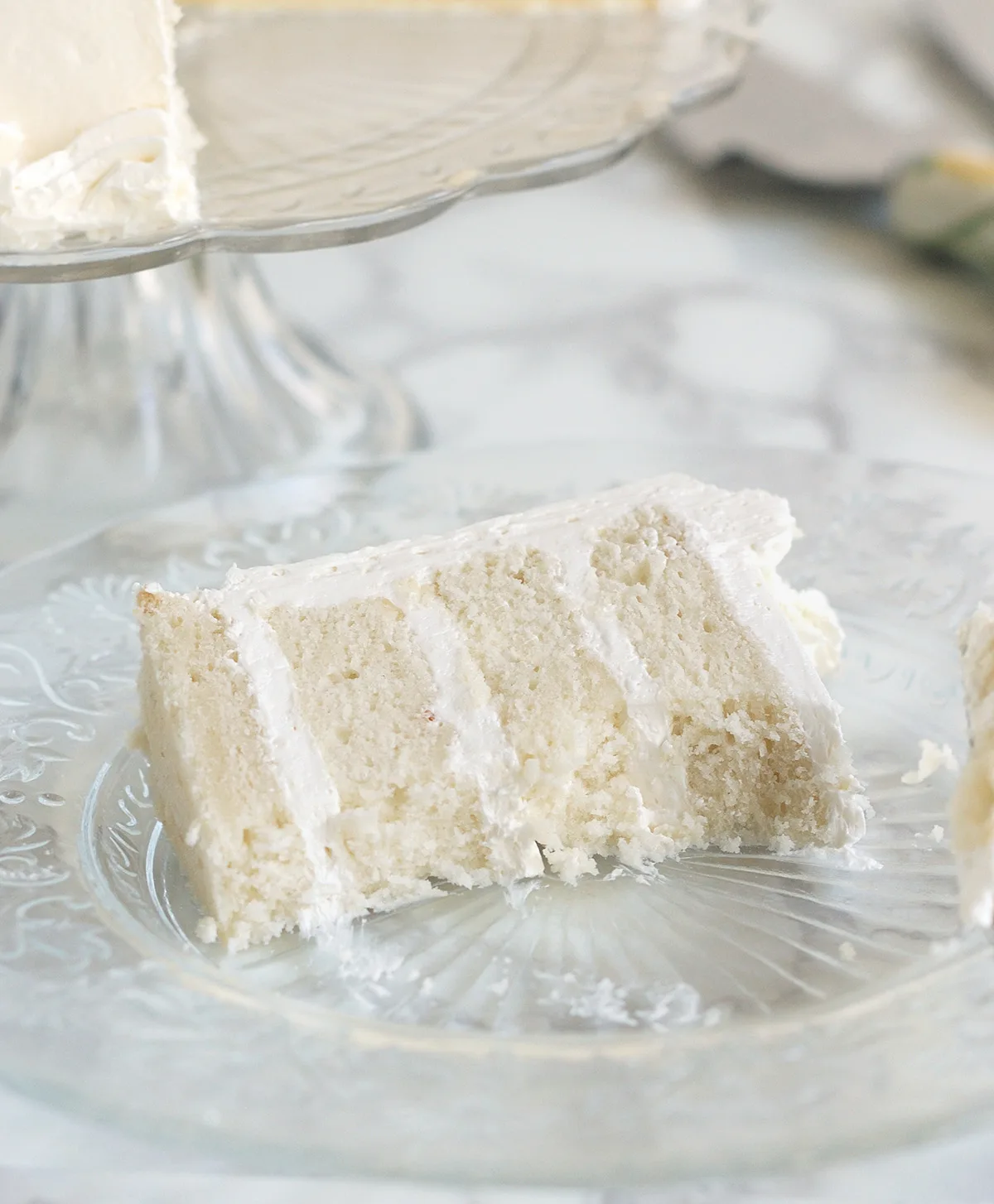
If you love this recipe as much as I do, I’d really appreciate a star rating and a quick comment. Ratings and comments help my recipes show in search results. Thanks!
White Cake Recipe
Video
Ingredients
- 9 ounces cake flour (2 cups, preferably bleached, see note)
- ¾ teaspoon baking powder
- ½ teaspoon baking soda
- ¾ teaspoon salt
- 12 ounces granulated sugar ( 1 ½ cups, divided)
- 8 ounces sour cream (1 cup, room temperature, divided)
- 8 ounces unsalted butter (room temperature (see note))
- 1 tablespoon vanilla extract
- 6 large egg whites (room temperature (see note))
- ½ teaspoon cream of tartar
Instructions
- Preheat the oven to 350 °F. Line two 8"x3" cake pans (don't use non-stick pans) with a circle of parchment paper or butter and flour the bottom of pans only. Do not butter and flour the sides of the pan.
- In a mixing bowl or the bowl of a stand mixer, sift 9 ounces cake flour, ¾ teaspoon baking powder, ½ teaspoon baking soda and ¾ teaspoon salt with 1 cup of the granulated sugar. Mix on low speed for 30 seconds to distribute the leavening. With the mixer on low speed, add half the sour cream and toss in 8 ounces unsalted butter a tablespoon at a time.
- Scrape the sides and bottom of the bowl. With the mixer running on low speed, add the remaining sour cream and 1 tablespoon vanilla extract.
- Increase the speed to medium and beat about 2-3 minutes until the batter lightens in texture and becomes aerated. If your using a hand mixer this may take an extra minute or two. Scrape the sides and bottom of the bowl to make sure there are no pockets of unmixed batter.
- In another bowl, 6 large egg whites with ½ teaspoon cream of tartar on medium high until they form soft peaks. Turn the mixer to medium low and slowly add the remaining ½ cup sugar. Turn the mixer to medium-high and whip the whites to full peak.
- Fold the whites into the base in 3 parts, folding just until there are no streaks of egg white. Divide the batter evenly between the 2 pans and spread to level.
- Bake 25-30 minutes until the center of the cake springs back when lightly pressed or a toothpick inserted into the middle of the cake comes out clean.
- Cool at least 20 minutes in the pan and then turn out onto a cooling rack. **The cake will "settle" a bit as it cools. That's fine.**
- Trim the brown edges off the cake, split each cake into two layers. Fill and ice with your favorite frosting.
Would you like to save this recipe?
Equipment
As an Amazon Associate and member of other affiliate programs, I earn from qualifying purchases.



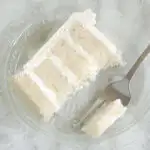






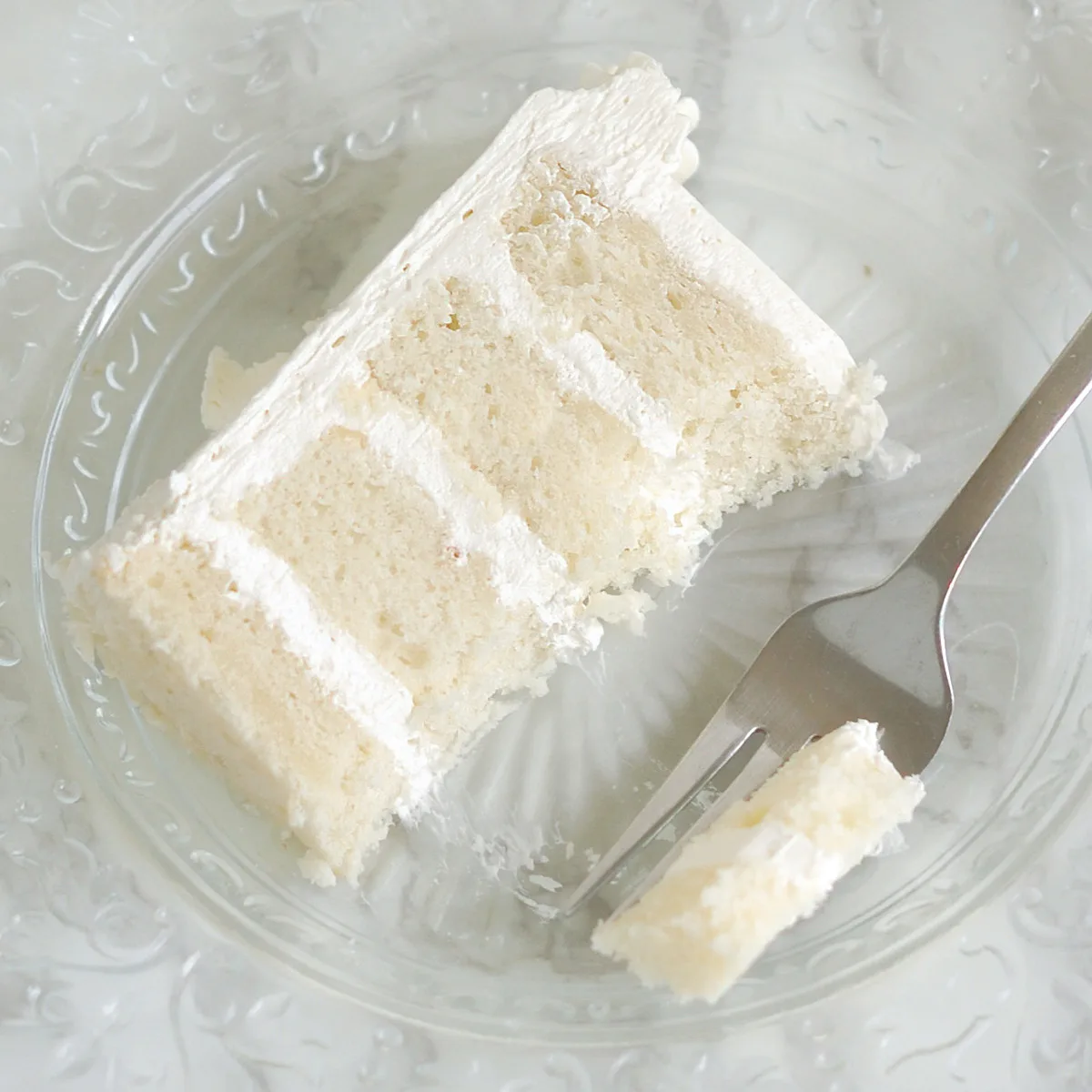
Hi Eileen,
I’ve been looking for a white cake recipe to try for my daughter’s 2nd birthday, and stumbled upon your recipe and your wonderful site. (I’m definitely going to keep coming back!). I made a test cake today, and it turned out well!
However, I don’t have a stand mixer, only a hand-held one, and I’m not sure if that makes a difference when adding the butter. I tested each tbsp of butter with an instant-read thermometer to ensure it reached the minimum 65ºF. When I added it to the dry ingredients, the butter didn’t mix too well. It collected in clumps, and I’m not sure if this is something that would happen with a stand mixer as well.
Once I added the sour cream, everything seemed to smooth out. I watched the video again, and it only shows the butter/sour cream mixture once the sour cream was already added, so I want to be sure this is normal.
Like I said, I got great results! But I noticed my cake was a little shorter in height than what you mention yours is, so I wonder if I’m missing something that could make it that much better/even a little lighter.
Thanks so much!
Hi Daniella, yes, the butter may clump up a bit before adding the sour cream. Especially in cold weather when not only the butter, but the mixing bowl, flour, sugar are all cooler. Unfortunately, I thought I had the camera on when I put in the butter and the sour cream, but I had it turned off by mistake so didn’t catch that part for the video. Based on your feedback I changed the recipe to add 1/2 the sour cream with the butter to loosen up the batter a bit. That should make it easier to mix. After adding the butter and sour cream continue beating for a couple of minutes and you should see the batter lighten in color and become aerated. I say 3-4 minutes in the recipe, but you can give it an extra minute or two if you don’t think you’re getting enough volume. Also, just fold in the whipped whites until there are no streaks of white visible. If you keep folding after the whites are mixed in you’ll knock out more of the air. Good luck and let me know how it turns out. Happy New Year!
Thanks for getting back to me so quickly! Everything you said makes sense, and I’ll try adding half the sour cream first. And also not over-folding the egg whites (in my enthusiasm for no streaks, it’s definitely possible I over-folded). I have one additional question for you: I’m making this cake well in advance of the event, so I’ll need to freeze the layers. And I know the idea of freezing layers seems simple–but I’m unsure of a few things… What do you wrap the cake in? Just plastic wrap? Aluminum foil? Do you wrap when the cake has completely cooled or while it’s still warm? Do you let the cake defrost/thaw completely before decorating with icing? Happiest of New Years to you!
Hi Daniella, I always double wrap the cakes in plastic and then a layer of foil. I wrap them once they’re cooled. I defrost them in the plastic wrap before decorating.
Hello Eileen,
I am planning to make this cake using 6”x2.5” pans. Can you please suggest what adjustments I should make to baking temperature or duration?
Thank you,
Kurt
Hi Kurt, I can’t give an exact time since it will depend on your oven and how full the pans are. But I would start checking the cakes after about 20 minutes. Either use the “toothpick” test (a toothpick inserted in the middle comes out clean) or, as I prefer, lightly press in the middle of the cake. If it springs back (doesn’t leave a dent) it’s done.
Hi Eileen I was wondering what is the icing recipe and if it requires powdered sugar.
Hi Lily, I use my Italian Meringue Buttercream for all my layer cakes. It does not require powdered sugar.
I want to use this recipe tomake six thin layers of cake separately (each layer will be a different color) but I’m trying to figure out if I’ll need to double the recipe; how many people would you say this cake would serve?
Also, any tips for a rookie doing a 6 layer cake lol I’ve got my cake board, I’m going to use firm buttercream frosting to layer and giant straws through it to help stabilize
Hi Eliza, This recipe makes enough batter for two cakes. I split each cake into two layers for a total of 4 layers. Each cake is about 2.5 to 3″ tall when baked. So the layers end up being about 1 to 1 1/2″ tall. I suggest you make 1 1/2 times the recipe for a total of six layers since you want 6 different colors. Do you have 6 cake pans? I’ve made 6-layer cakes plenty of times and never used straws for support. Are you worried about the layers shifting?
Thank you I thought 1 and 1/2 too but wasn’t sure. Yes I am very worried about it shifting as I’ve never made a layer cake before and it’s for my sons birthday party and yes I went out and bought 6 cake pans just for this actually :p
What a good mom you are! What type of buttercream will you use the fill the cake? Will you be transporting it to another location?
Yes I’ll be transporting it
I was going to use a classic American buttercream recipe but halve the butter and add shortening so it’s firmer.
Well, once you have the layers stacked you can decide if you think it’s stable enough to transport without extra support. I think it should be, but use your own judgement.
It turned out perfectly and without straws for support, thank you so much!
I forgot the baking soda. Will the cakes still taste okay?
I think the taste will be fine, it probably just won’t rise as much as it should.